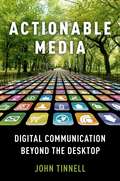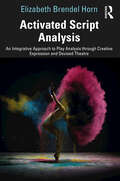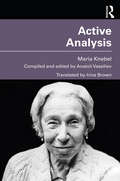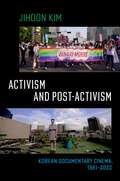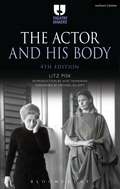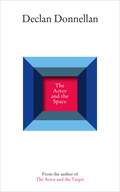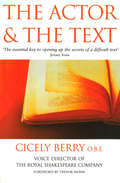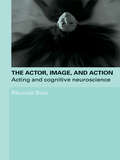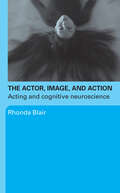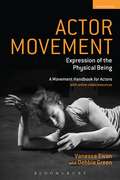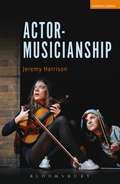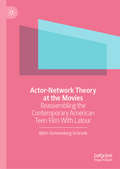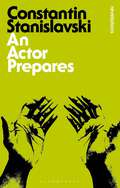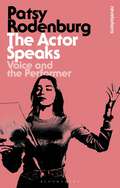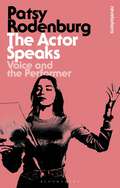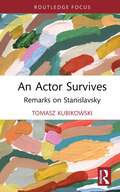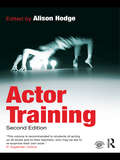- Table View
- List View
Actionable Media: Digital Communication Beyond the Desktop
by John TinnellIn 1991, Mark Weiser and his team at Xerox PARC declared they were reinventing computers for the twenty-first century. The computer would become integrated into the fabric of everyday life; it would shift to the background rather than being itself an object of focus. The resulting rise of ubiquitous computing (smartphones, smartglasses, smart cities) have since thoroughly colonized our digital landscape. In Actionable Media, John Tinnell contends that there is an unsung rhetorical dimension to Weiser's legacy, which stretches far beyond recent iProducts. Taking up Weiser's motto, "Start from the arts and humanities," Tinnell develops a theoretical framework for understanding nascent initiatives--the Internet of things, wearable interfaces, augmented reality--in terms of their intellectual history, their relationship to earlier communication technologies, and their potential to become vibrant platforms for public culture and critical media production. It is clear that an ever-widening array of everyday spaces now double as venues for multimedia authorship. Writers, activists, and students, in cities and towns everywhere, are digitally augmenting physical environments. Audio walks embed narratives around local parks for pedestrians to encounter during a stroll; online forums are woven into urban infrastructure and suburban plazas to invigorate community politics. This new wave of digital communication, which Tinnell terms "actionable media," is presented through case studies of exemplar projects by leading artists, designers, and research-creation teams. Chapters alter notions of ubiquitous computing through concepts drawn from Bernard Stiegler, Gregory Ulmer, and Hannah Arendt; from comparative media analyses with writing systems such as cuneiform, urban signage, and GUI software; and from relevant stylistic insights gleaned from the open air arts practices of Augusto Boal, Claude Monet, and Janet Cardiff. Actionable Media challenges familiar claims about the combination of physical and digital spaces, beckoning contemporary media studies toward an alternative substrate of historical precursors, emerging forms, design philosophies, and rhetorical principles.
ACTIONABLE MEDIA C: Digital Communication Beyond the Desktop
by John TinnellIn 1991, Mark Weiser and his team at Xerox PARC declared they were reinventing computers for the twenty-first century. The computer would become integrated into the fabric of everyday life; it would shift to the background rather than being itself an object of focus. The resulting rise of ubiquitous computing (smartphones, smartglasses, smart cities) have since thoroughly colonized our digital landscape. In Actionable Media, John Tinnell contends that there is an unsung rhetorical dimension to Weiser's legacy, which stretches far beyond recent iProducts. Taking up Weiser's motto, "Start from the arts and humanities," Tinnell develops a theoretical framework for understanding nascent initiatives--the Internet of things, wearable interfaces, augmented reality--in terms of their intellectual history, their relationship to earlier communication technologies, and their potential to become vibrant platforms for public culture and critical media production. It is clear that an ever-widening array of everyday spaces now double as venues for multimedia authorship. Writers, activists, and students, in cities and towns everywhere, are digitally augmenting physical environments. Audio walks embed narratives around local parks for pedestrians to encounter during a stroll; online forums are woven into urban infrastructure and suburban plazas to invigorate community politics. This new wave of digital communication, which Tinnell terms "actionable media," is presented through case studies of exemplar projects by leading artists, designers, and research-creation teams. Chapters alter notions of ubiquitous computing through concepts drawn from Bernard Stiegler, Gregory Ulmer, and Hannah Arendt; from comparative media analyses with writing systems such as cuneiform, urban signage, and GUI software; and from relevant stylistic insights gleaned from the open air arts practices of Augusto Boal, Claude Monet, and Janet Cardiff. Actionable Media challenges familiar claims about the combination of physical and digital spaces, beckoning contemporary media studies toward an alternative substrate of historical precursors, emerging forms, design philosophies, and rhetorical principles.
Activated Script Analysis: An Integrative Approach to Play Analysis through Creative Expression and Devised Theatre
by Elizabeth Brendel HornActivated Script Analysis engages theatre students in traditional formative script analysis through a fusion of devised theatre and various modes of creative expression, dispelling the notion of script analysis as an isolated pen-to-paper task and reimagining it as a captivating and collaborative process. This book uses diverse, contemporary plays to model the script analysis process for each of four Theatrical Elements: Given Circumstances; Character; Setting; and Structure. By considering each of these elements, readers can uncover patterns and themes within a dramatic text. Woven throughout the study of each theatrical element are "Connections": Personal Connections, which encourage readers to explore a theatrical element within their own lives, as though their lives were a script; Play Connections, which make abstract ideas presented in script analysis concrete through theatre-based play; Professional Connections, which examine how a theatre professional might analyze a script within their own work; and Performative Connections, which provide the opportunity for students to explore a theatrical element through performance using devised theatre strategies. At the end of each chapter, readers are given the opportunity to analyze a text through the lens of a Theatrical Element and to express their findings through a variety of digital, written, visual, and performance-based modes of expression. Activated Script Analysis is designed for undergraduate theatre students and educators, to be used as the primary text in Script Analysis coursework or as a supplemental text in Acting or Directing courses. The book includes access to downloadable templates and example videos, available at www.routledge.com/9781032125398.
Activated Script Analysis: An Integrative Approach to Play Analysis through Creative Expression and Devised Theatre
by Elizabeth Brendel HornActivated Script Analysis engages theatre students in traditional formative script analysis through a fusion of devised theatre and various modes of creative expression, dispelling the notion of script analysis as an isolated pen-to-paper task and reimagining it as a captivating and collaborative process. This book uses diverse, contemporary plays to model the script analysis process for each of four Theatrical Elements: Given Circumstances; Character; Setting; and Structure. By considering each of these elements, readers can uncover patterns and themes within a dramatic text. Woven throughout the study of each theatrical element are "Connections": Personal Connections, which encourage readers to explore a theatrical element within their own lives, as though their lives were a script; Play Connections, which make abstract ideas presented in script analysis concrete through theatre-based play; Professional Connections, which examine how a theatre professional might analyze a script within their own work; and Performative Connections, which provide the opportunity for students to explore a theatrical element through performance using devised theatre strategies. At the end of each chapter, readers are given the opportunity to analyze a text through the lens of a Theatrical Element and to express their findings through a variety of digital, written, visual, and performance-based modes of expression. Activated Script Analysis is designed for undergraduate theatre students and educators, to be used as the primary text in Script Analysis coursework or as a supplemental text in Acting or Directing courses. The book includes access to downloadable templates and example videos, available at www.routledge.com/9781032125398.
Active Analysis
by Maria KnebelActive Analysis combines two of Maria Knebel’s most important books, On Active Analysis of the Play and the Role and The Word in the Actor’s Creative Work, in a single edition conceived and edited by one of Knebel's most famous students, the renowned theatre and film director, Anatoli Vassiliev. This is the first English translation of an important and authoritative fragment of the great Stanislavski jigsaw. A landmark publication. This book is an indispensable resource for professional directors, student directors, actors and researchers interested in Stanislavski, directing, rehearsal methods and theatre studies more generally.
Active Analysis
by Maria KnebelActive Analysis combines two of Maria Knebel’s most important books, On Active Analysis of the Play and the Role and The Word in the Actor’s Creative Work, in a single edition conceived and edited by one of Knebel's most famous students, the renowned theatre and film director, Anatoli Vassiliev. This is the first English translation of an important and authoritative fragment of the great Stanislavski jigsaw. A landmark publication. This book is an indispensable resource for professional directors, student directors, actors and researchers interested in Stanislavski, directing, rehearsal methods and theatre studies more generally.
Activism and Post-activism: Korean Documentary Cinema, 1981--2022
by Jihoon KimActivism and Post-activism: Korean Documentary Cinema, 1981--2022 is a new book about nonfiction filmmaking in the private and independent sectors of South Korean cinema and media from the early 1980s to the present day. Drawing on the methodologies of documentary studies, experimental film and video, digital cinema, local discourses on independent documentary, and the literature on the social changes of South Korea, author Jihoon Kim historicizes the formation and development of Korean independent documentary in close dialogue with South Korea's social movements. From the 1980s mass anti-dictatorship movement to twenty-first-century labor issues, feminism, LGBT rights, environmental justice, and key events such as the Sewol Ferry disaster and the Candlelight Protests, Kim offers a comprehensive history of Korean social change documentaries in terms of their activist tradition. At the same time, Kim also maps out the formal and aesthetic divergences of twenty-first-century Korean documentary cinema beyond the activist tradition, while also demonstrating how they have inherited and dynamically renewed the tradition's engagement with contested reality and history. Making the tripartite connections between the socio-political history of South Korea, documentary's aesthetics and politics, and the shifting institutional and technological evolution of documentary production and distribution, the book argues that what is unique about this forty-year history of South Korean documentary cinema is the intensive and compressed coevolution of its two interlocked tendencies: activism and post-activism.
Activism and Post-activism: Korean Documentary Cinema, 1981--2022
by Jihoon KimActivism and Post-activism: Korean Documentary Cinema, 1981--2022 is a new book about nonfiction filmmaking in the private and independent sectors of South Korean cinema and media from the early 1980s to the present day. Drawing on the methodologies of documentary studies, experimental film and video, digital cinema, local discourses on independent documentary, and the literature on the social changes of South Korea, author Jihoon Kim historicizes the formation and development of Korean independent documentary in close dialogue with South Korea's social movements. From the 1980s mass anti-dictatorship movement to twenty-first-century labor issues, feminism, LGBT rights, environmental justice, and key events such as the Sewol Ferry disaster and the Candlelight Protests, Kim offers a comprehensive history of Korean social change documentaries in terms of their activist tradition. At the same time, Kim also maps out the formal and aesthetic divergences of twenty-first-century Korean documentary cinema beyond the activist tradition, while also demonstrating how they have inherited and dynamically renewed the tradition's engagement with contested reality and history. Making the tripartite connections between the socio-political history of South Korea, documentary's aesthetics and politics, and the shifting institutional and technological evolution of documentary production and distribution, the book argues that what is unique about this forty-year history of South Korean documentary cinema is the intensive and compressed coevolution of its two interlocked tendencies: activism and post-activism.
The Actor and His Body (Theatre Makers)
by Litz Pisk Ayse Tashkiran'Once you start working with someone like Litz you don't ever want to stop if you can help it' - Vanessa Redgrave Litz Pisk was widely regarded as the most influential teacher of modern theatre movement of the 20th Century. She innovated and advocated a physical training that sought to combine awareness, emotion and imagination specifically for the actor's craft. Her seminal book, The Actor and His Body, is the direct result of her unique dual career as a professional movement director and as an actor movement teacher working in leading British conservatoires. Pisk's quest was to find expression for the inner impulse that motivated actors to move. Her teachings, as outlined in this book, offer insight on the specific craft of the actor, and the relationship between movement, imagination and the 'need' to move. The Actor and His Body is also a practical manual for keeping the actor's body physically and expressively responsive. In addition, there are a range of movement exercises, illuminated by her exquisite line drawings, and a complete weekly programme which concentrates on movement practice within different timescales. This fourth edition features the original foreword by Michael Elliot as well as a new introduction by Ayse Tashkiran, contemporary movement director and Senior Lecturer at the Royal Central School of Speech and Drama, which contextualises Pisk's work.
The Actor and His Body (Theatre Makers)
by Litz Pisk Ayse Tashkiran'Once you start working with someone like Litz you don't ever want to stop if you can help it' - Vanessa Redgrave Litz Pisk was widely regarded as the most influential teacher of modern theatre movement of the 20th Century. She innovated and advocated a physical training that sought to combine awareness, emotion and imagination specifically for the actor's craft. Her seminal book, The Actor and His Body, is the direct result of her unique dual career as a professional movement director and as an actor movement teacher working in leading British conservatoires. Pisk's quest was to find expression for the inner impulse that motivated actors to move. Her teachings, as outlined in this book, offer insight on the specific craft of the actor, and the relationship between movement, imagination and the 'need' to move. The Actor and His Body is also a practical manual for keeping the actor's body physically and expressively responsive. In addition, there are a range of movement exercises, illuminated by her exquisite line drawings, and a complete weekly programme which concentrates on movement practice within different timescales. This fourth edition features the original foreword by Michael Elliot as well as a new introduction by Ayse Tashkiran, contemporary movement director and Senior Lecturer at the Royal Central School of Speech and Drama, which contextualises Pisk's work.
The Actor and the Space
by Declan DonnellanIn his bestselling book The Actor and the Target, Declan Donnellan laid out a fresh and radical approach to acting that has inspired actors around the world. Now, in The Actor and the Space, he develops and extends those ideas, exploring that most profound source of vitality in life as well as performance: the space around us. Tackling fundamental questions that face any actor – What makes performance better? How do I create a space for my character to live in? How do I tap into that space, and draw energy from it? – Donnellan offers a universal set of keys to unlock the mysteries of performance. Full of insightful precepts, acute psychology and practical, hands-on advice, the book presents a bold new way of thinking about acting, illustrated throughout with line-by-line analysis of scenes from Macbeth to show how it works in rehearsal and performance. Essential reading for any actor or theatre director, The Actor and the Space is also a fascinating distillation of the work of a world-leading director that will reward and enrich anyone with an interest in theatre. 'A hand grenade of a book. It contains all the humility and chutzpah you need to work in the theatre.' Cate Blanchett 'A wonderful book. Few directors think as deeply or perceptively about the art of acting as Declan Donnellan. This is an essential text for the actor, supremely useful, practical, elegant and profound.' Matthew Macfadyen 'Beautifully clear. This generous vision takes a very complex art form and makes it all seem so simple. The whole book is a key. Unlocking the problems actors face as they try to accept another reality long enough to let the audience get a glimpse of the best our art can offer – a glimpse into themselves.' Adrian Lester 'Declan Donnellan's profound insight and point of departure is that great theatre, like a child's sandcastle, inhabits a vulnerable and ever-changing space between the safe and the dangerous. There is a whole lot of wisdom in this book – about tragedy, human psychology, words, dread and about how great acting really works – conveyed with remarkable clarity and simplicity. It's worth sharing with non-actor friends for its insights into Macbeth alone. Most of all, it's a distillation of hard-won lessons learned from decades of immersion in the mysteries of theatre by one of the great directors of our day.' James Shapiro, Shakespeare scholar and author of 1599: A Year in the Life of William Shakespeare
The Actor And The Text
by Cicely BerryCicely Berry, Voice Director of the Royal Shakespeare Company, is world-famous for her voice teaching. The Actor and the Text is her classic book, distilled from years of working with actors of the highest calibre.
The Actor, Image, and Action: Acting and Cognitive Neuroscience
by Rhonda BlairThe Actor, Image and Action is a 'new generation' approach to the craft of acting; the first full-length study of actor training using the insights of cognitive neuroscience. In a brilliant reassessment of both the practice and theory of acting, Rhonda Blair examines the physiological relationship between bodily action and emotional experience. In doing so she provides the latest step in Stanislavsky's attempts to help the actor 'reach the unconscious by conscious means'. Recent developments in scientific thinking about the connections between biology and cognition require new ways of understanding many elements of human activity, including: imagination emotion memory physicality reason. The Actor, Image and Action looks at how these are in fact inseparable in the brain's structure and function, and their crucial importance to an actor’s engagement with a role. The book vastly improves our understanding of the actor's process and is a must for any actor or student of acting.
The Actor, Image, and Action: Acting and Cognitive Neuroscience
by Rhonda BlairThe Actor, Image and Action is a 'new generation' approach to the craft of acting; the first full-length study of actor training using the insights of cognitive neuroscience. In a brilliant reassessment of both the practice and theory of acting, Rhonda Blair examines the physiological relationship between bodily action and emotional experience. In doing so she provides the latest step in Stanislavsky's attempts to help the actor 'reach the unconscious by conscious means'. Recent developments in scientific thinking about the connections between biology and cognition require new ways of understanding many elements of human activity, including: imagination emotion memory physicality reason. The Actor, Image and Action looks at how these are in fact inseparable in the brain's structure and function, and their crucial importance to an actor’s engagement with a role. The book vastly improves our understanding of the actor's process and is a must for any actor or student of acting.
Actor Movement: Expression of the Physical Being (Performance Books)
by Vanessa Ewan Debbie GreenActor Movement: Expression of the Physical Being is a textbook and video resource for the working actor, the student and all those who lead and witness movement for the actor, including movement tutors, movement directors and directors. Great actors are not simply great interpreters of text; they are also great interpreters of movement; able to 'embody' all aspects of a character's life, with body and imagination as their instruments. In their work they are expected to become many bodies, all behaving differently from their own. Actors have to construct, inhabit and offer each character's body, with its multiplicity of known and unknown physical expression. Featuring: Over 155 exercises Four full actor movement processes for creating character Over 20 illustrations and images Complementary online footage supporting 26 of the practical elementsInspiring confidence in the actor to make fully owned physical choices and develop a love of movement, this essential new textbook is ideal for those actors seeking to give to their movement all the complexity and range possible for great acting.
Actor Movement: Expression of the Physical Being (Performance Books)
by Vanessa Ewan Debbie GreenActor Movement: Expression of the Physical Being is a textbook and video resource for the working actor, the student and all those who lead and witness movement for the actor, including movement tutors, movement directors and directors. Great actors are not simply great interpreters of text; they are also great interpreters of movement; able to 'embody' all aspects of a character's life, with body and imagination as their instruments. In their work they are expected to become many bodies, all behaving differently from their own. Actors have to construct, inhabit and offer each character's body, with its multiplicity of known and unknown physical expression. Featuring: Over 155 exercises Four full actor movement processes for creating character Over 20 illustrations and images Complementary online footage supporting 26 of the practical elementsInspiring confidence in the actor to make fully owned physical choices and develop a love of movement, this essential new textbook is ideal for those actors seeking to give to their movement all the complexity and range possible for great acting.
Actor-Musicianship (Performance Books)
by Jeremy HarrisonActor-musicianship is a permanent feature of the musical theatre landscape. Actor-musician shows can be seen from Bradford to Broadway, from village halls to international arena tours. However, with the exception of a couple of academic papers, there has been nothing written about this fascinating area of theatre practice. Jeremy Harrison's book addresses this deficit, operating as both a record of the development of the actor-musician movement and as a practical guide for students, educators, performers and practitioners. It explores the history of actor-musicianship, examining its origins, as well as investigating – and offering guidance on – how this specialist form of music theatre is created. It, in turn, acts as a means of defining an art form that has to date been left to lurk in the shadows of musical theatre; a subset with its own distinctive culture of performer, maker and audience, but as yet no formal recognition as a specialism in its own right. The actor-musician show is multifarious and as such this book targets those interested in mainstream commercial work, as well as alternative and avant-garde theatre practice. The book draws together expertise from a range of disciplines with contributions from many of the leading figures in this field, including performers, directors, teachers, MDs, producers and writers. It also features a foreword by theatre director John Doyle.
Actor-Musicianship (Performance Books)
by Jeremy HarrisonActor-musicianship is a permanent feature of the musical theatre landscape. Actor-musician shows can be seen from Bradford to Broadway, from village halls to international arena tours. However, with the exception of a couple of academic papers, there has been nothing written about this fascinating area of theatre practice. Jeremy Harrison's book addresses this deficit, operating as both a record of the development of the actor-musician movement and as a practical guide for students, educators, performers and practitioners. It explores the history of actor-musicianship, examining its origins, as well as investigating – and offering guidance on – how this specialist form of music theatre is created. It, in turn, acts as a means of defining an art form that has to date been left to lurk in the shadows of musical theatre; a subset with its own distinctive culture of performer, maker and audience, but as yet no formal recognition as a specialism in its own right. The actor-musician show is multifarious and as such this book targets those interested in mainstream commercial work, as well as alternative and avant-garde theatre practice. The book draws together expertise from a range of disciplines with contributions from many of the leading figures in this field, including performers, directors, teachers, MDs, producers and writers. It also features a foreword by theatre director John Doyle.
Actor-Network Theory at the Movies: Reassembling the Contemporary American Teen Film With Latour
by Björn Sonnenberg-SchrankThis book is one of the first to apply the theoretical tools proposed by French philosopher Bruno Latour to film studies. Through the example of the Hollywood Teen Film and with a particular focus on Actor-Network Theory (ANT), the book delineates how Teen Film has established itself as one of Hollywood’s most consistent and dynamic genres. While many productions may recycle formulaic patterns, there is also a proliferation of cinematic coming-of-age narratives that are aesthetically and politically progressive, experimental, and complex. The case studies develop a Latourian film semiotics as a flexible analytical approach which raises new questions, not only about the history, types and tropes of teen films, but also about their aesthetics, mediality, and composition. Through an exploration of a wide and diverse range of examples from the past decade, including films by female and African-American directors, urban and rural perspectives, and non-heteronormative sexualities, Actor-Network Theory at the Movies demonstrates how the classic Teen Film canon has been regurgitated, expanded, and renewed.
An Actor Prepares (Bloomsbury Revelations)
by Constantin StanislavskiAn Actor Prepares is the most famous acting training book ever to have been written and the work of Stanislavski has inspired generations of actors and trainers. This translation was the first to introduce Stanislavski's 'system' to the English speaking world and has stood the test of time in acting classes to this day. Stanislavski here deals with the inward preparation an actor must undergo in order to explore a role to the full. He introduces the concepts of the 'magic of' units and objectives, of emotion memory, of the super-objective and many more now famous rehearsal aids. An inspirational book presented in a drama class structure to ignite powerful performances.
The Actor Speaks: Voice and the Performer (Bloomsbury Revelations)
by Patsy RodenburgFrom the bestselling author of The Right to Speak and The Need for Words comes this Bloomsbury Revelations edition of the essential guide to voice work: The Actor Speaks. Beginning with what every first-year acting student faces in class and ending with what leading professional actors must achieve every night on stage, Patsy Rodenburg's celebrated work as one of the world's foremost voice and acting coaches is fully revealed in this thoughtful and inspirational book about acting.Written for the training and working actor, Rodenburg's book brings to life a wide range of exercises and methods to release the actor's voice, covering everything from posture, breath and the body, performing in specific spaces, previews and first performances, managing different length runs, using microphones and dealing with an ageing or sick voice. This book allows the reader to perform every night, reaching the pitch, passion and vocal intensity that the best roles require.
The Actor Speaks: Voice and the Performer (Bloomsbury Revelations)
by Patsy RodenburgFrom the bestselling author of The Right to Speak and The Need for Words comes this Bloomsbury Revelations edition of the essential guide to voice work: The Actor Speaks. Beginning with what every first-year acting student faces in class and ending with what leading professional actors must achieve every night on stage, Patsy Rodenburg's celebrated work as one of the world's foremost voice and acting coaches is fully revealed in this thoughtful and inspirational book about acting.Written for the training and working actor, Rodenburg's book brings to life a wide range of exercises and methods to release the actor's voice, covering everything from posture, breath and the body, performing in specific spaces, previews and first performances, managing different length runs, using microphones and dealing with an ageing or sick voice. This book allows the reader to perform every night, reaching the pitch, passion and vocal intensity that the best roles require.
An Actor Survives: Remarks on Stanislavsky (Routledge Advances in Theatre & Performance Studies)
by Tomasz KubikowskiThis book focuses on the analysis and interpretation of the first volume of the book An Actor’s Work by Konstantin Stanislavsky. This volume is the only part of his planned major work on theatre art that he was able to finish and authorise before his death. Its highly edited variant has long been known as ‘An Actor Prepares’ in the English-speaking world. Tomasz Kubikowski explores Stanislavsky’s material not only as a handbook of acting but also as a philosophical testament of Stanislavsky, in which he attempts to contain his most essential experiences and reflections. This book explores the underlying theme of ‘survival’ in its various meanings, from professional to existential; and the mechanisms and actions we attempt to survive. This study will be of great interest to students and scholars in theatre and performance studies.
An Actor Survives: Remarks on Stanislavsky (Routledge Advances in Theatre & Performance Studies)
by Tomasz KubikowskiThis book focuses on the analysis and interpretation of the first volume of the book An Actor’s Work by Konstantin Stanislavsky. This volume is the only part of his planned major work on theatre art that he was able to finish and authorise before his death. Its highly edited variant has long been known as ‘An Actor Prepares’ in the English-speaking world. Tomasz Kubikowski explores Stanislavsky’s material not only as a handbook of acting but also as a philosophical testament of Stanislavsky, in which he attempts to contain his most essential experiences and reflections. This book explores the underlying theme of ‘survival’ in its various meanings, from professional to existential; and the mechanisms and actions we attempt to survive. This study will be of great interest to students and scholars in theatre and performance studies.
Actor Training
by Alison HodgeActor Training expands on Alison Hodge’s highly-acclaimed and best-selling Twentieth Century Actor Training. This exciting second edition radically updates the original book making it even more valuable for any student of the history and practice of actor training. The bibliography is brought right up to date and many chapters are revised. In addition, eight more practitioners are included - and forty more photographs - to create a stunningly comprehensive study. The practitioners included are: Stella Adler; Eugenio Barba; Augusto Boal; Anne Bogart; Bertolt Brecht; Peter Brook; Michael Chekhov; Joseph Chaikin; Jacques Copeau; Philippe Gaulier; Jerzy Grotowski; Maria Knebel; Jacques Lecoq; Joan Littlewood; Sanford Meisner; Vsevolod Meyerhold; Ariane Mnouchkine; Monika Pagneux; Michel Saint-Denis; W?odzimierz Staniewski; Konstantin Stanislavsky; Lee Strasberg The historical, cultural and political context of each practitioner’s work is clearly set out by leading experts and accompanied by an incisive and enlightening analysis of the main principles of their training, practical exercises and key productions. This book is an invaluable introduction to the principles and practice of actor training and its role in shaping modern theatre.
